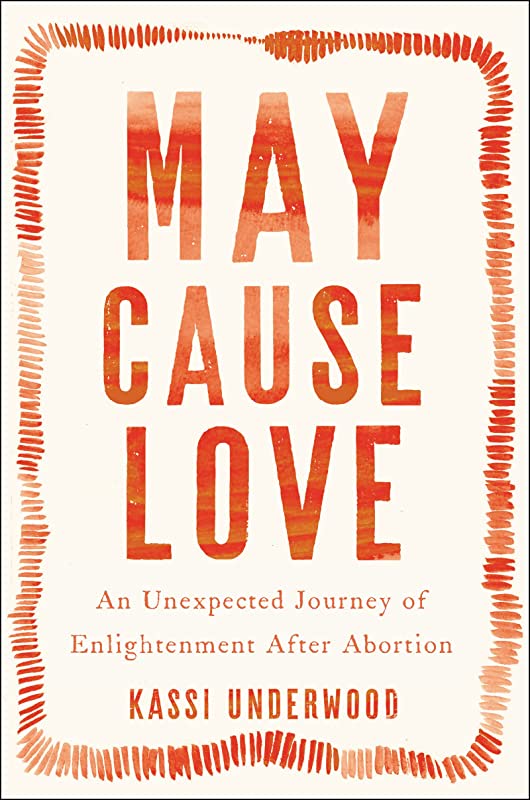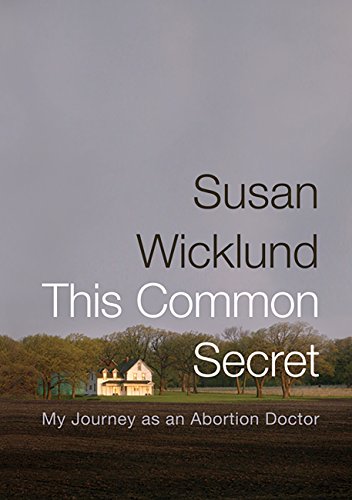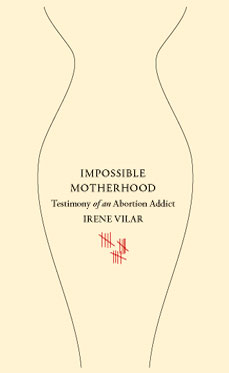My Reading Life: The Abortion Books, Part 4 (Personal "Pro-Choice" Stories)
I need to start this post with a disclaimer. I read five personal stories from women who were in some way connected to the abortion debate. To keep this post from being even longer, I divided the personal stories into two posts: those written by women who believe abortion should be legal, and those written by women who believe it should not. I use the terms “pro-choice” and “anti-abortion” because I do not feel “pro-choice” and “pro-life” accurately sums up the two camps. People who believe abortion should be legal hold a wide spectrum of beliefs about its morality; and those who feel it should be illegal don’t always hold as high a regard for “life” as their name would imply.
This Common Secret: My Journey as an Abortion Doctor by Susan Wickland
“Flower Grandma sighed and held my hand tight. Tears welled in her eyes.
‘I know exactly what kind of work you do, and it is a good thing. People like you do it safely so that people like me don’t murder their best friends. I told you how proud I am of what you do, and I meant it.'”
– Susan Wicklund, describing her grandmother’s reaction when she confessed the details of her profession for the first time in This Common Secret.
I first came across this book when I was shelving it as a library clerk. The cover caught my attention. The farmhouse surrounded by trees looked like the ones I’ve driven past my whole life, like the one I grew up in. The rural image was deeply familiar to me. And I also knew about the secrets we keep in such communities beneath a facade of conformity and functionality.
I found the book again at a booksale put on annually by the local Lutheran college, and I purchased it there. Eight years later I finally cracked the spine.
What I most wanted from this book was light shed on the idea that “those things don’t happen here,” and it does provide that. Dr. Wicklund shares stories of her interactions with patients in a wide array of circumstances, as well as her own deeply personal reasons for deciding to pursue this career. The harrowing story in the opening chapter should give at least a moment’s pause to anyone who believes abortion should be illegal in all circumstances.
What surprised me about the book was how incredibly threatened Dr. Wicklund felt throughout her career. She received death threats at her home and place of work; had her home surrounded by protesters while her adolescent daughter was trying to get to school; wore disguises and bulletproof vests and and hid in the trunks of cars so she could get to work unharmed.
All this, at a time when abortion was legal throughout the country.
Medical abortions might be incredibly safe for women, but they are still dangerous for doctors.
And although I believe that the question of abortion should be addressed in the moral and not the legal realm, I wish we could at least find enough common ground to agree that expressing your deeply held convictions should not result in professionals living their lives in constant fear of violence. Because while abortion was legal while Wicklund was practicing, I often felt that the peril she faced was much greater than the peril faced by the women providing illegal abortions in The Story of Jane. The women of Jane were mostly anonymous. Dr. Wicklund was a constant target.
This book has an obvious pro-choice slant, and Wicklund clearly selected cases with the least moral ambiguity in the decisions women made to have abortions — although she does include a couple stories of abortions she regretted performing. She also perpetuates an often misquoted and inflated statistic about how many women previously died from illegal abortions. But for the most part, she cites her sources. And there is no arguing with the lived experience of her and her patients.
I’m glad I started my foray into personal stories with this one. Anti-abortionists want nothing more than for the public to believe that abortion doctors are profit-driven murderers. Yet the number of abortion providers in the country continues to plummet, and reading Dr. Wicklund’s story it’s easy to see why. No amount of money would motivate most people to put their lives, families, and mental health on the line the way Dr. Wicklund did. In one scene, she invites a regular protester to have coffee with her, and in this interaction the protester sees that she is a person with her own moral compass, not a monster. She did not change his convictions, nor was that her goal. More of these conversations should be happening. But they can’t if abortion doctors and others who are pro-choice fear violence when they share space with those on the other side.
Impossible Motherhood: Testimony of an Abortion Addict by Irene Vilar
“My story is a perversion of both maternal desire and abortion, framed by a lawful procedure that I abused.”
– Irene Vilar, Impossible Motherhood
I tried to take in every personal story I read about abortion with compassion and an open heart, but sometimes that was harder than others.
Ms. Vilar’s story is the “worst-case scenario” imagined by people on both sides of the abortion debate, that women will use the availability of legal abortion as “birth control.”
On the surface, Irene Vilar is one of those oft-maligned women. She takes her birth control unreliably, then lets her pregnancies continue for far too long before ultimately terminating them — fifteen times. But there’s more to her story than that. Isn’t there always?
Beneath the cycle of birth control failure, pregnancy, and abortion is an isolated woman attempting to cope with her abusive, predatory partner and a lifetime of trauma. As a child, Irene witnessed her own mother commit suicide. Although she does not say it explicitly, it seemed to me that her repeated unplanned pregnancies were her body’s expression of the ambivalence she felt about her adult relationship. She wanted children, but her lover insisted that he would drop her the moment she tried to “ensnare” him with any, frequently badmouthing his previous lovers who had “sold out” in response to their biological clocks. Deep down, she wanted to drive him away, and pregnancy seemed the surest way to do that. But once the pregnancy was underway, the pattern of abuse kept her from having the courage to actually leave. She terminated pregnancies rather than the relationship.
When she finally breaks free from him, she reflects on the fact that she hated the abortions–the pain, the judgmental doctors, the ending of possibility. What got her “high” (her words) was the uncertainty of whether a pregnancy would occur, then the possibility of becoming a mother and forming a new relationship to her child.
What this memoir painfully instilled in me is the knowledge that, if abortion is legal, we must accept that some women will use it in ways that we don’t agree with. And we must understand that there is always, always more to the story than we assume.
May Cause Love: An Unexpected Journey of Enlightenment After Abortion by Kassi Underwood

“What that story didn’t say was, the same conservative system that set up so many of us to get pregnant by accident, was the same creepy system that made bringing a child into the world seem like a brutal thing to do.”
– Kassi Underwood, May Cause Love
This was probably my favorite book that I read for this project.
Although I did feel like it went on about 100 pages longer than necessary, and while the ending felt pretty trite, it doesn’t insist on a single narrative around abortion. And it deeply explores why painting abortion as an issue with only two distinct sides (abortion is no big deal vs. abortion is murder) silences and damages women.
Kassi grew up in a conservative Southern home. She never thought she was the type of woman who would get an abortion. Until she found herself pregnant as a freshman in college, drinking too much and cheating on her long-distance boyfriend with a drug addict (the father). Her only options seemed to be having an abortion and following her life trajectory as planned, or having the baby, moving back home with her mom, and delaying or cancelling the plans she’d had for herself.
Although she chose the abortion and felt it was the “right” decision, it also haunted her. For years, reminders of it would trigger post-traumatic stress flashbacks. But she feared expressing these difficult emotions would give fodder to those who want to make abortion illegal. Not expressing them felt inauthentic.
First, she makes meaning of the abortion by getting sober and pursuing career success: “I wasn’t just wasting one life anymore–I was wasting two,” she says of her decision to clean up her act. Eventually, though, she knows that achievement alone won’t heal her wound, and she goes on a personal journey toward healing through various channels: a Buddhist ceremony for abortions, miscarriages, or stillbirths; a Catholic retreat for women to heal from abortions; private therapy sessions and interviews with academics studying abortion. Each of these experiences gives her another piece of the puzzle, until she can begin to feel gratitude for her abortion not because she had more opportunities without a child, but because it set her on a path toward deepening her spirituality that brought her all the way to Harvard Divinity School.
The vision she holds of a culture that has space for the complicated reality of abortion is one that resonates with me.
We would honor life and death, grief and suffering, friendships and romance, a love of one’s own body, mother wounds and daddy issues, the divine. There would be listening and validation, but no coddling, no insistence that abortion was universally the “right decision” or the “wrong decision.” If one of us determined that the wrong decision had been made, then we would embrace this admission as an integral personal acknowledgment of wrongdoing, not an indictment of reproductive rights.
And although her personal story is very different from my own, I’m grateful to Kassi for refusing to accept the easy narrative. Perhaps I had some hope that doing this self-directed reading study would help me “clarify” my own complicated feelings about abortion. It hasn’t. When I read something stridently pro-choice, there’s this little voice in my head that says, “But what about …?” and when I read something vehemently anti-abortion, an even louder voice asks, “But what about …?”
And maybe that’s the way it should be. Maybe we’re only really in trouble when those little voices of doubt are so threatening that we’ll trample anyone who reminds us there could be more than one right answer. Or perhaps no right answer at all.

